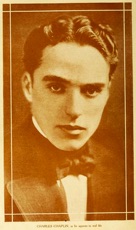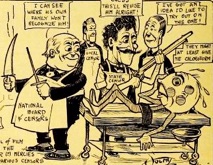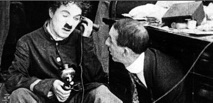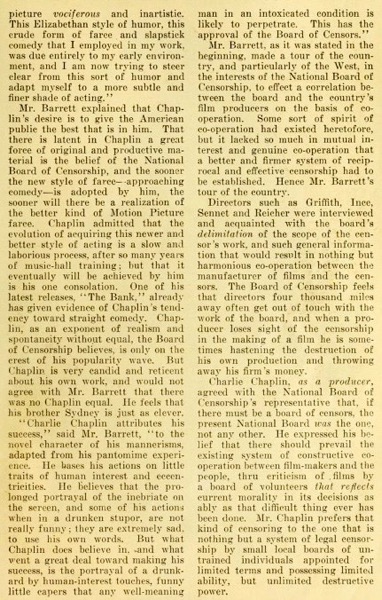The Bank Clippings 39/46
J. B. Hirsch, Motion Picture, New York, January 1916.
Charles Chaplin, as he appears in real life.
(...) Photo, Motion Picture, Jan. 1916
& The Bank Scene
& National, Local and State Censorship
(...) Cartoon, Motion Picture, April 1916
„This has the approval of the Board of Censors“
Editorial content. „The New Charlie Chaplin
By J. B. Hirsch
Here´s´a new Charlie Chaplin! The most universally known slapstick comedian of the film has burst the tawdry
chrysalis of that Charlie Chaplin of the English music-hall
manner and manners. The old Charlie Chaplin has
seen that the very methods by which his personality achieved
success now imperil his unprecedented reputation
by alienating a great part of the American public, to whom
the novelty of his fun-making appeals less as
familiarity with his farce bares offensive vulgarities. He has
realized the menace to his popularity, which has made
him not at all ,up-stage,‘ and pursues a new fame, to be built
on the basis of a more delicate art that will not
countenance the broad sallies his old technique demanded –
methods that his new metamorphosis eliminates
as not in keeping with the American conception of humor.
This is the impression of the National Board of Censorship,
gained by W. W. Barrett, of the executive staff of the
board, in an interview recently with Mr. Chaplin in the Essanay
studios in Los Angeles. Mr. Barrett, who returned
the early part of this week from a tour of the United States
made in the interests of the censorship board, had
much to tell about his experiences with many of the world‘s
greatest Motion Picture directors and actors. Charlie
Chaplin, the director, actor, writer and manager of his own
pictures, impressed Mr. Barrett more than did any
of the other screen personalities with whom he came
in contact.
Secretary Barrett explained that the National Board
of Censorship had taken an unusual interest in Chaplin‘s work,
and expressed his belief that there are great possibilities
in the comedian‘s future work, both as a helpful influence in a
community and as a factor in the artistic development
of the Motion Picture.
An intimate afternoon spent with Chaplin in and about
his studio served to convey to the censor impressions
of Charlie Chaplin, not as we see him – cutting up funny capers
and making faces – but ,close-up‘ impressions which
revealed Chaplin the artist and the business man. His critic
found him to be – unlike and contrary to his stage
appearance – a neatly and stylishly dressed young man;
as charming and affable a boy – for he appeared
to be but a youth – as anyone would wish to meet; a hard
worker, who writes, acts, produces and manages;
an unusually intelligent man, modest, not in the least
affected by his great popularity, and very keen,
businesslike and thrifty – not at all like the usual actor of the
,get-rich-quick‘ variety. Such is Charlie Chaplin as the
National Board of Censorship sees him.
A heart-to-heart talk between Mr. Barrett and Chaplin
revealed to the former the comedian‘s thoughts
and plans for the future. According to Mr. Barrett, Chaplin, who
is only twenty-five years old, is very ambitious. He has
shaped for himself the slogan, ,Art for art‘s sake,‘ and he has
dreams of unmeasured possibilities for the future of the
films – all from an artistic point of view. When he talks of the
change he intends to make in his style of farce,
it is in a very serious vein. He spoke thus to the censor man:
,It is because of my music-hall training and
experiences that I am by force of habit inclined to work into
my acting little threads of vulgarisms – not to hurt any
one, but, in my opinion, and from an artist‘s point of view, enough
to render the picture vociferous and inartistic. The
Elizabethan style of humor, this crude form of farce and
slapstick comedy that I employed in my work, was
due entirely to my early environment, and I am now trying
to steer clear from this sort of humor and adapt
myself to a more subtle and finer shade of acting.‘
Mr. Barrett explained that Chaplin‘s desire is to give the
American public the best that is in him. That there
is latent in Chaplin a great force of original and productive
material is the belief of the National Board of Censorship,
and the sooner the new style of farce – is adopted by him, the
sooner will there will be a realization of the better kind
of Motion Picture farce. Chaplin admitted that the evolution
of acquiring this newer and better style of acting is a
slow and laborious process, after so many years of music-hall
training; but that it eventually will be achieved by him
is his one consolation. One of his latest releases, The Bank,
already has given evidence of Chaplin‘s tendency
toward straight comedy. Chaplin, as an exponent of realism
and spontaneity without equal, the Board of Censorship
believes, is only on the crest of his popularity wave. But Chaplin
is very candid and reticent about his own work, and
would not agree with Mr. Barrett that there was no Chaplin
equal. He feels that his Brother Sydney is just
as clever.
,Charlie Chaplin attributes his success,‘ said Mr. Barrett,
,to the novel character of his mannerisms, adapted
from his pantomime experience. He bases his actions on little
traits of human interest and eccentricities. He believes
that the prolonged portrayal of the inebriate on the screen, and
some of his actions when in a drunken stupor, are not
really funny; they are extremely sad, to use his own words. But
what Chaplin does believe in, and what went a great
deal toward making his success, is the portrayal of a drunkard
by human-interest touches, funny little capers that
any well-meaning man in an intoxicated condition is likely
to penetrate. This has the approval of the Board
of Censors.‘
Mr. Barrett, as it was stated in the beginning, made
a tour of the country, and particularly of the West,
in the interests of the National Board of Censorship, to effect
a correlation between the board and the country‘s
film producers on the basis of cooperation. Some sort of spirit
of co-operation had existed heretofore, but it lacked
so much in mutual interest and genuine co-operation that
a better and firmer system of reciprocal and effective
censorship had to be established. Hence Mr. Barrett‘s tour
of the country.
Directors such as Griffith, Ince, Sennet(t) and Reicher
were interviewed and acquainted with the board‘s
delimitation of the scope of the censor‘s work, and such
general information that would result in nothing but harmonious
co-operation between the manufacturer of films and
the censors. The Board of Censorship feels that directors
four thousand miles away often get out of touch with
the work of the board, and when a producer loses sight of the
censorship in the making of a film he is sometimes
hastening the destruction of his own production and throwing
away his firm‘s money.
Charlie Chaplin, as a producer, agreed with the National
Board of Censorship‘s representative that, if there must
be a board of censors, the present National Board was the one,
not any other. He expressed his belief that there should
prevail the existing system of constructive cooperation between
film-makers and the people, thru criticism of films
by a board of volunteers that reflects current morality in its
decisions as ably as that difficult thing ever has been
done. Mr. Chaplin prefers that kind of censoring to the one
that is nothing but a system of legal censorship by
small local boards of untrained individuals appointed for
limited terms and possessing limited ability, but
unlimited destructive power.“
Redaktioneller Inhalt




